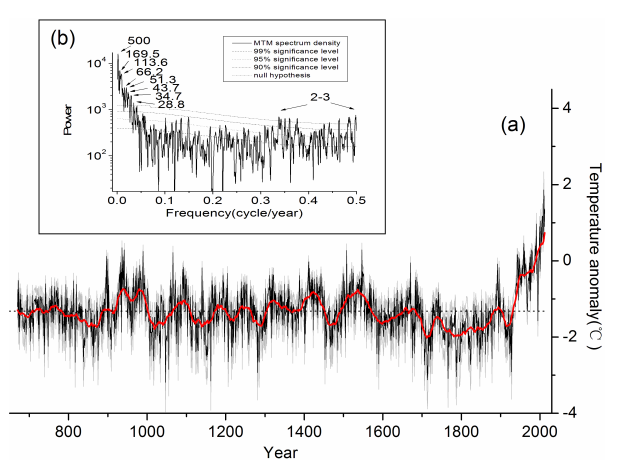A new temperature reconstruction of the last millennium, published by Zhang et al for open review in Climate of the Past Discussions, has a pronounced hockey-stick shape. The authors construct a 1300-year long ring-width chronology from juniper trees in the Qilian mountains on the northern flank of the Tibetan plateau.

Reconstructed temperature in the Qilian Mountains, red line is 31 yr running mean. Inset: MTM spectral density of the temperature reconstruction.
Of interest to this blog is the claim that there is a fingerprint of solar variability in the power spectrum.
The centennial cycles identified in our study, i.e. those of 113.6–169 and 500 yr, were possibly associated with the frequencies of solar variations
This is a very weak claim.
First, although the labelled spectral peaks are all high above the 99% significance level, that significance level does not account for (I think) multiple testing. So if we were interested in testing for an 11 year cycle, it is correct, but not if we are testing for the presence of any cycle.
Second, there are wide spectral bands that are believed to contain solar variability: the DeVries–Suess cycle with a period of 170–260 years, and the Gleissberg cycle with periods between 50–80 and 90–140 years (Ogurtsov et al, 2002). If there are many apparently significant periodicities, it would be surprising if none were in solar bands.
Third, the non-stationarity in the reconstruction – the dramatic increase in temperature during the 20th Century – is almost certain to affect the analysis at long periodicities.
In short, this is another paper that can be added to my growing list of articles that purport to find solar influence on palaeoclimatic proxies but where the evidence is very weak.
UPDATE
Kevin Anchukaitis (@thirstygecko) points me towards Qin et al (2013) who find that precipitation rather than temperature predicts juniper ring-widths at their tree-line study site a couple of hundred kilometres away from Zhang et al’s study site. Zhang et al find precipitation to correlate much well with their ring-widths than temperature. It is possible that Qin et al‘s area is somewhat dryer, making it more precipitation sensitive. Although Zhang et al’s study site is currently not (mainly) precipitation limited, the area would not have needed to have become much dryer for the trees to be precipitation limited in the past. One would need to look at independent precipitation reconstructions from the region, to determine if past drought could be interfering with the temperature reconstruction. Isotopic analysis of the tree-rings might also help.
Also meriting a note of caution, the reconstructions for most of the period before 1900 are at or beyond the end of the calibration space.
Ogurtsov, MG, Nagovitsyn, YA, Kocharov, GE, and Jungner, H 2002. Long-period cycles of the sun’s activity recorded in direct solar data and proxies. Solar Phys., 211, 371-394
Qin C, Yang B, Melvin TM, Fan Z, Zhao Y, et al. 2013. Radial Growth of Qilian Juniper on the Northeast Tibetan Plateau and Potential Climate Associations. PLoS ONE 8, e79362. doi:10.1371/journal.pone.0079362
Zhang Y, Shao X, Yin Z-Y and Wang Y 2014. Millennial Minimum Temperature Variations in the Qilian Mountains, China: evidence from Tree rings. Clim. Past Discuss., 10, 341–380

 @richardjtelford
@richardjtelford